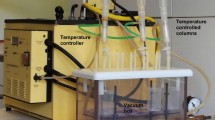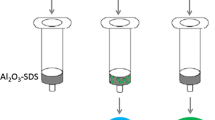Abstract
A system using an ion chromatograph coupled to a flow-cell scintillation detector for rapidly measuring the oxidation states of actinides at low concentrations (<10–6M) in aqueous solutions was evaluated. The key components of the system are a cation–anion separation column (Dionex, CS5) and a flow cell detector with scintillating cerium activated glass beads. The typical procedure was to introduce a 0.5 ml aliquot of sample spiked with actinides in the +III to +VI oxidation states into a 5 ml sample loop followed by 4 ml of synthetic groundwater simulant. Separation was achieved at a flow rate of 1 ml/min using an isocratic elution with oxalic, diglycolic, and nitric acids followed by distilled water. Tests were first conducted to determine elution times and recoveries for an acidic solution (pH ≈ 2) and a ground water simulant (pH ≈ 8) containing Am(III), Pu(IV), Th(IV), Pu(V), and U(VI). Then, an analysis was performed using a mixture of Pu(IV), Pu(V), and Pu(VI) in the ground water simulant and compared to results using the DBM extraction technique. Approximate elution times were the same for both the acidic solution and the ground water simulant. These were as follows: Pu(V) at 10 min, Am(III) at 15 min, Pu(IV) at 25 min, Th (IV) at 28 min and U(VI) at 36 min. Recoveries for the acidic solution were quantitative for U(VI) and Th(IV) and exceeded 80% for Am(III). Recoveries for the ground water simulant were quantitative for U(VI), but they were generally not quantitative for Th(IV), Pu(IV), and Am(III). For Th(IV) and Pu(IV), less than quantitative recoveries were attributed to the formation of neutral hydroxides and colloids; for Am(III) they were attributed to insoluble carbonates and/or hydroxycarbonates. When applied to the measurement of plutonium in the ground water simulant, the technique provided showed good agreement with the dibenzoylmethane (DBM) extraction technique, but it could not distinguish between Pu(V) and Pu(VI). This was likely due to the reduction of Pu(VI) to Pu(V) in the sample by the oxalic acid eluent. However, in spite of this limitation, the technique can be used to distinguish between Pu(IV) and Pu(V) in aqueous environmental samples within a pH range of 4 to 8 and an E H range of -0.2 to 0.6 V, the predominance region for Pu(III), (IV), and (V). In addition, this technique can be used to corroborate oxidation state analysis from the dibenzoylmethane (DBM) extraction method for environmental samples.
Similar content being viewed by others
References
G. R. Choppin, B. Allard, in: Handbook on the Physics and Chemistry of the Actinides, A. M. Freeman and C. Keller (Eds), North Holland Publishing, Amsterdam, 1984.
S. C. Foti, E. C. Freiling, Talanta, 11 (1964) 385.
P. Bertrand, G. R. Choppin, Radiochim. Acta, 31 (1982) 135.
A. Saito, G. R. Choppin, Anal. Chem., 55 (1983) 2454.
M. P. Neu, D. C. Hoffman, K. E. Roberts, H. Nitsche, R. J. Silva, Radiochim. Acta, 66 (1994) 265.
G. R. Choppin, A. H. Bond, P. M. Hromadka, J. Radioanal. Nucl. Chem., 219 (1997) 203.
D. Schramke, O. Rai, R. W. Fulton, G. R. Choppin, J. Radioanal. Nucl. Chem., 130 (1989) 333.
D. Bradbury, G. R. Elder, M. J. Dunn, in: Proc. Symp. on Waste Management, Vol. 2, Tucson, AZ, 1990, p. 327.
S. H. Reboul, Qualitative and Quantitative Analysis of Alpha and Beta Emitting Radionuclides by Ion Chromatography and On-line Scintillation Counting, PhD Dissertation, Clemson University, Clemson, SC, 1995.
S. Reboul, R. A. Fjeld, Health Phys., 68 (1995) 585.
S. Reboul, R. A. Fjeld, Radioac. Radiochem., 5 (1994) 42.
R. J. Silva, G. Bidoglio, M. H. Rand, P. B. Robouch, H. Wanner, I. Puigdomenech, Chemical Thermodynamics of Americium, Elsevier Scientific Publishing, New York, 1995.
G. H. Coleman, The Radiochemistry of Plutonium, NAS-NS-3058, National Research Council, Washington, DC, 1965.
Author information
Authors and Affiliations
Rights and permissions
About this article
Cite this article
Coates, J.T., Fjeld, R.A., Paulenova, A. et al. Evaluation of a rapid technique for measuring actinide oxidation states in a ground water simulant. Journal of Radioanalytical and Nuclear Chemistry 248, 501–506 (2001). https://doi.org/10.1023/A:1010677419619
Issue Date:
DOI: https://doi.org/10.1023/A:1010677419619




